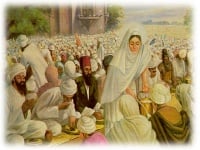Template:AOW175: Difference between revisions
Hari singh (talk | contribs) (New page: {{aowh|Mata Khivi <small><small>organiser of the langar system</small></small>}} thumb|250px|right|{{c|[[Mata Khivi serving Langar}}]] '''Mata Khiv...) |
Hari singh (talk | contribs) No edit summary |
||
| (3 intermediate revisions by the same user not shown) | |||
| Line 1: | Line 1: | ||
{{aowh|[[Mata Khivi|Mata Khivi <small><small>organiser of the langar system</small></small>]]}} | {{aowh|[[Mata Khivi|Mata Khivi <small><small>organiser of the langar system</small></small>]]}} | ||
[[Image:Khivi.jpg|thumb| | [[Image:Khivi.jpg|thumb|200px|right|{{c|[[Mata Khivi]] serving [[Langar]]}}]] | ||
'''Mata Khivi''' (1506 - 1582) was born in 1506 to [[Karan Devi]] and [[Bhai Devi Chand]] [[Khatri]] in a small town called Sanghar which is now located in the province of Sindh in [[Pakistan]]. | '''[[Mata Khivi]]''' ([[1506]] - [[1582]]) was born in [[1506]] to [[Karan Devi]] and [[Bhai Devi Chand]] [[Khatri]] in a small town called Sanghar which is now located in the province of Sindh in [[Pakistan]]. | ||
There is historical evidence that she had 4 children. [[Dasu]], the eldest was born in 1524. [[Bibi Amro]] was born in 1532, followed by [[Bibi Anokhi]] in 1535 and son [[Datu]] in 1537. The family was content and doing well. As the wife of one of the town's richest men, Khivi must have enjoyed a great deal of respect. Her life was one of luxury and pleasure. | Her father was a shopkeeper and trader, and was a popular man in the neighbourhood. His daughter inherited all his finest attributes of generosity and congenial spirit. | ||
She was married in 1519, when she was 13 years old. Khivi was married to [[Lahina]] for 20 years before he became the second [[Guru]] of the [[Sikh]]s. | |||
There is historical evidence that she had 4 children. [[Dasu]], the eldest was born in 1524. [[Bibi Amro]] was born in 1532, followed by [[Bibi Anokhi]] in 1535 and son [[Datu]] in 1537. The family was content and doing well. As the wife of one of the town's richest men, Khivi must have enjoyed a great deal of respect. Her life was one of luxury and pleasure. <!-------- | |||
Life would have gone on this way, had it not been for her coming under the influence of Mai Bhirai, who told her about [[Guru Nanak]]'s teachings. At approximately the same time, Lahina also heard of the Guru through [[Bhai Jodha]], one of [[Guru Nanak]]'s earliest disciples. Lahina was a seeker of truth, and his curiosity was aroused. | Life would have gone on this way, had it not been for her coming under the influence of Mai Bhirai, who told her about [[Guru Nanak]]'s teachings. At approximately the same time, Lahina also heard of the Guru through [[Bhai Jodha]], one of [[Guru Nanak]]'s earliest disciples. Lahina was a seeker of truth, and his curiosity was aroused. | ||
In 1532, shortly after the birth of his first daughter Amro, [[Lahina]] set out for his annual pilgrimage. On the way, he broke his journey at [[Kartarpur]] to see the Guru. On listening to [[Nanak]] speak, Lahina begged to be allowed to stay and become his disciple. He had found the truth he had been seeking, and would never again stray away from it. He served his master with the greatest devotion. He busied himself, sweeping the visitor's quarters, washing their clothes and helping with the most menial work in fields | In 1532, shortly after the birth of his first daughter Amro, [[Lahina]] set out for his annual pilgrimage. On the way, he broke his journey at [[Kartarpur]] to see the Guru. On listening to [[Nanak]] speak, Lahina begged to be allowed to stay and become his disciple. He had found the truth he had been seeking, and would never again stray away from it. He served his master with the greatest devotion. He busied himself, sweeping the visitor's quarters, washing their clothes and helping with the most menial work in fields. ------->{{aowf|Mata Khivi}} | ||
Latest revision as of 19:01, 4 October 2012

Mata Khivi (1506 - 1582) was born in 1506 to Karan Devi and Bhai Devi Chand Khatri in a small town called Sanghar which is now located in the province of Sindh in Pakistan.
Her father was a shopkeeper and trader, and was a popular man in the neighbourhood. His daughter inherited all his finest attributes of generosity and congenial spirit.
She was married in 1519, when she was 13 years old. Khivi was married to Lahina for 20 years before he became the second Guru of the Sikhs.
There is historical evidence that she had 4 children. Dasu, the eldest was born in 1524. Bibi Amro was born in 1532, followed by Bibi Anokhi in 1535 and son Datu in 1537. The family was content and doing well. As the wife of one of the town's richest men, Khivi must have enjoyed a great deal of respect. Her life was one of luxury and pleasure. .....More
